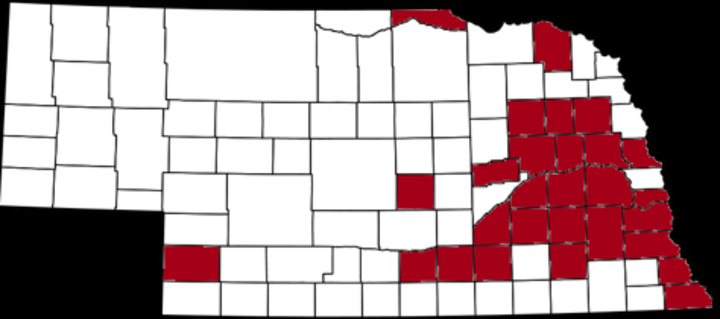How are Nebraskans using cover crops? A survey of Nebraska soybean, field corn, and seed corn producers and agronomists offers insights into why they've adopted cover crops and how they've integrated them into their cropping systems.
The survey was conducted during the 2017 Cover Crop Conference at the Eastern Nebraska Research and Extension Center in February 2017. A total of 82 growers and agronomists, representing 28 counties (mainly from eastern Nebraska), completed the survey (Figure 2).
Of the 82 respondents, 66 identified themselves as growers and seven as agronomists/consultants. (Nine did not respond.) Eighty-seven percent of survey participants had adopted cover crops as part of their cropping systems (72 individuals). Respondents farmed/managed 369,005 acres, of which 59,892 acres were planted with cover crops. Of the growers/consultants who reported planting cover crops, the percent of their total acres planted to cover crops varied from 2.5% to 100%, with an average of 32%.

Cover Crop Seeding and Species Selection
Of the survey participants who had established cover crops in soybean, 27% said they seed prior to harvest while 73% do so after crop harvest (Figure 3). Drilling after crop harvest is the main method of seeding cover crops in soybean years (72%), followed by aerial seeding (28%). Cereal rye is used by 43% of the respondents while a cover crop mix (of at least two species) is used by 57% (cereal rye plus oats, radishes, and/or vetch were common answers).
Of the respondents who seeded cover crops in field corn, 27% said they seed prior to harvest while 73% seed after crop harvest. Drilling after crop harvest is the main method for planting cover crops (66%), followed by aerial seeding (26%; typically done when crop reaches maturity) and interseeding (8%). Cereal rye is used by 47% of the respondents, while a mix of species was used by 53%. (Cereal rye plus radishes, and/or vetch were common mixes used.)

Among respondents who seeded cover crops in seed corn, 85% said they plant prior to harvest while 15% plant after harvest. Interseeding cover crops after destruction of male rows is the main seeding practice in seed corn years (77%), followed by aerial seeding (15%) and drilling (8%). All of these respondents used a mix of species (radishes, turnips and cereal mix was a common answer).
Cover Crop Termination and Herbicide Program
More than 95% of cover crop growers reported using herbicides for cover crop termination. Of this group, 100% reported using glyphosate. Of these, 2,4-D was added by 50%, paraquat (e.g., Gramoxone) by 9%, or glufosinate (e.g., Liberty) by 6%, as part of the tank mix with glyphosate. According to participants 33%, 21%, and 44% apply pre-emergent herbicides at cover crop termination, at crop planting, and at both cover crop termination and crop planting, respectively.
Impact of Cover Crop Adoption in Production Systems
According to respondents, reduced soil erosion has been the main benefit observed (45%) where cover crops have been adopted followed by weed suppression (29%), increased soil organic matter (24%), increased soil tilth (19%), increased soil water infiltration (10%), and improved soil fertility (5%; Figure 4). Additional benefits described were reduced pesticide use, increased grazing ability, and uniform yields (2%). A few producers reported reduced crop yields and increased erosion where cover crops had been adopted (2%).

Challenges with Incorporating Cover Crops
According to the respondents who had adopted cover crops, the biggest challenge has been planting and establishing a stand before winter due to the short growing season, time, and/or equipment (56%). Termination of cover crops in the spring was ranked as the second biggest challenge (37%). Herbicide carryover impeding cover crop establishment in the fall (7%), cost (5%), and crop yield reduction (2%) were the remaining challenges reported by participants (Figure 5).
Conclusion
There are many ways cover crops can be incorporated in cropping systems and the results of this survey highlight the main strategies, benefits and challenges observed by these Nebraska cover crop growers.

When deciding how best to use cover crops, it is important to consider the ultimate goal. Is it to increase soil organic matter, increase nutrient availability to subsequent crops, reduce soil compaction, supply forage for livestock, and/or suppress weeds? Answering these questions will help identify the cover crop strategies that offer the best chance of success for meeting the goal.
For more information see the Nebraska Extension NebGuide Cover Crops: A Primer (G2284) and the survey report.
Acknowledgments
Thank you to the growers and consultants who participated, Nebraska Extension Educator Keith Glewen for allowing us to conduct the survey, and Jacqueline Herrick, office associate at the West Central Research and Extension Center for processing the data.

